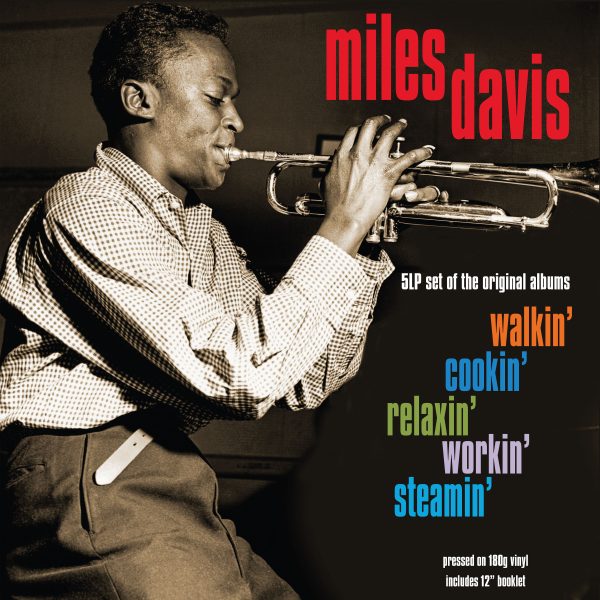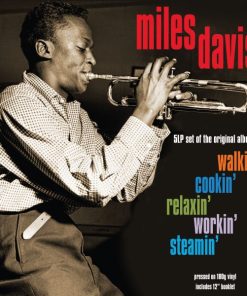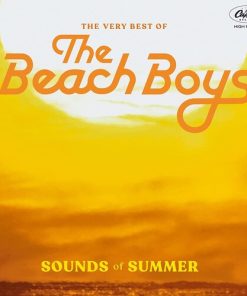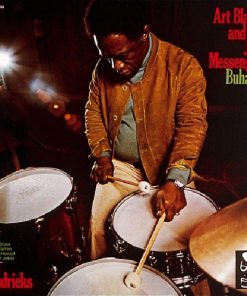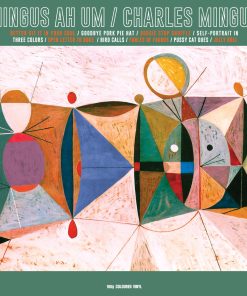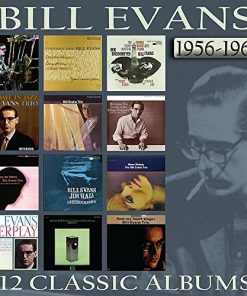MILES DAVIS: Walkin’, Cookin’, Relaxin’, Workin’, Steamin’ (5 VINYL LPS) NOT NOW MUSIC
$ 76,99 $ 38,49
![]()
Walkin’ was released under the name of The Miles Davis All Stars, but in truth the Trumpeter co-led the date with trombonist J.J. Johnson. In his biography on Davis, Musician Ian Carr outlined the circumstances surrounding this recording, which had been preceded by no rehearsal due to the Prestige record label’s refusal to pay for such a luxury. Therefore, the session had an air of spontaneity. This was a signal that Miles had emerged from a very dull artistic period and, on the title track, the third chorus of his solo sets his improvisation apart from Bebop and takes it beyond stylistic pigeonholes. Elsewhere, a comparison to Armstrong is made which implies both a step forward for Miles without forgetting where the music had come from. Another highlight of this album is the performance of Blue ‘N’ Boogie, on which Miles’ explorations are matched by the elastic Trombone of the session’s co-leader Johnson and some soulful outpouring from Thompson. The success of this date comes from the empathy between the musicians and a clear understanding by the rhythm section of the cushion required by the front line.
The Cookin’ album typifies the group’s approach to both standards and original compositions. The atmosphere of the release is, at the same time, a study in close-knit harmony and relaxation which comes from a group of musicians performing regularly together. A high level of sophistication is present on When Lights Are Low and My Funny Valentine, which Miles would record to even greater effect in the following decade. Coltrane can be heard to be blossoming in this company, even if his search for that elusive individuality seemed to be a constant battle that he would very soon win. The rhythm section is about as perfect a unit as one could wish, Garland often introducing those ‘block chords’ he became famous for. Chambers is suitably loose and agile, while Jones’ addiction to Swing fitted the picture perfectly. Miles himself had started to establish that style of playing that made one note carry as much weight as half-a-dozen delivered by most any other Trumpeter. His use of space equally as important as what he played.
It is difficult to choose from any of the Prestige albums as being superior to any other, for the ‘consistency in quality’ is the phrase most apposite when considering any of them. Relaxin’ is typical of the balance between the songs from Tin Pan Alley and Jazz compositions. If I Were A Bell and I Could Write A Book, representing the former and Sonny Rollins’ Oleo the latter. These renditions are classic in conception and it’s not overstating the case to suggest that, as far as the standards are concerned, these could be the definitive Jazz versions on record.
On many occasions, all of this music has been suggested as essential to any serious Jazz collection – and, when listening to the beautiful version of It Never Entered My Mind from Workin’ it’s impossible not to concur. The Rodgers & Hart show tune opens the album and features Red Garland’s delicate arpeggios, while using a muted horn, Davis states the main melody. Also included is a version of Dave Brubeck’s In Your Own Sweet Way which finds Davis back using a Harmon Mute on his Trumpet, bringing a sense of fragility to the melody.
With new-found confidence, the need for Davis to form his own band became paramount, and this led to him forming the first of his great line-ups. He chose a bunch of relative unknowns to make up a Quintet whose music created a stir within the Jazz world. As his frontline partner he picked Tenor Saxophonist John Coltrane. Coltrane himself would be hailed as a creative genius during the forthcoming years but in the mid-50’s his star shone no brighter than any other Saxophonist. The rest of the group was made up of Pianist Red Garland, Paul Chambers on Bass and Philly Joe Jones on drums. This is not to say that sceptics did not exist with regard to the group’s qualities – in his original sleeve note for the Steamin’ album Joe Goldberg described the line-up ‘The group consisted, we are told, of a Trumpet Player who could only play in the middle register and fluffed half his notes; an out-of-tune Tenor Player; a Cocktail Pianist; a Drummer who played so loud no one else could be heard; and a teenage Bassist.’ Such perceived deficiencies rarely, if ever, surfaced within the lifetime of the Quintet, and most leaders would embrace the brilliance of ‘a teenage Bassist’ at any time. Not to be Missed is Coltrane’s composition Trane’s Blues with its walking bass-lines and improvised Trumpet and Sax solos, which would prove to be influentially exploratory.

WALKIN’
LP 1 Side One
1. Walkin’
2. Blue ‘n’ Boogie
LP 1 Side Two
1. Solar
2. You Don’t Know What Love Is
3. Love Me Or Leave Me
COOKIN’
LP 2 Side One
1. My Funny Valentine
2. Blues By Five
LP 2 Side Two
1. Airegin
2. Tune Up / When Lights Are Low
RELAXIN’
LP 3 Side One
1. If I Were A Bell
2. You’re My Everything
3. I Could Write A Book
LP 3 Side Two
1. Oleo
2. It Could Happen To You
3. Woody ‘N’ You
WORKIN’
LP4 Side One
1. It Never Entered My Mind
2. Four
3. In Your Own Sweet Way
4. The Theme (Take 1)
LP4 Side Two
1. Trane’s Blues A.K.A ‘Weird Blues’
2. Ahmad’s Blues
3. Half Nelson
4. The Theme (Take 2)
STEAMIN’
LP5 Side One
1. The Surrey With The Fringe On Top
2. Salt Peanuts
3. Something I Dreamed Last Night
LP5 Side Two
1. Diane
2. Well You Needn’t
3. When I Fall In Love
Fast Shipping and Professional Packing
Due to our longstanding partnership with UPS FedEx DHL and other leading international carriers, we are able to provide a range of shipping options. Our warehouse staff are highly trained to pack your goods exactly according to the specifications that we supply. Your goods will undergo a thorough examination and will be safely packaged prior to being sent out. Everyday we deliver hundreds of packages to our customers from all over the world. This is an indication of our dedication to being the largest online retailer worldwide. Warehouses and distribution centers can be located in Europe as well as the USA.
Orders with more than 1 item are assigned processing periods for each item.
Before shipment, all ordered products will be thoroughly inspected. Today, most orders will be shipped within 48 hours. The estimated delivery time is between 3-7 days.
Returns
The stock is constantly changing. It's not entirely managed by us since we are involved with multiple parties such as the factory and our storage. The actual stock can fluctuate at any time. Please understand it may happen that your order will be out of stock when the order is placed.
Our policy is valid for 30 days. If you haven't received your product within 30 days, we're not able to issue either a return or exchange.
You are able to return a product if it is unused and in the same condition when you received it. It must also still remain in the original packaging.
Related products
MUSIC CDS
